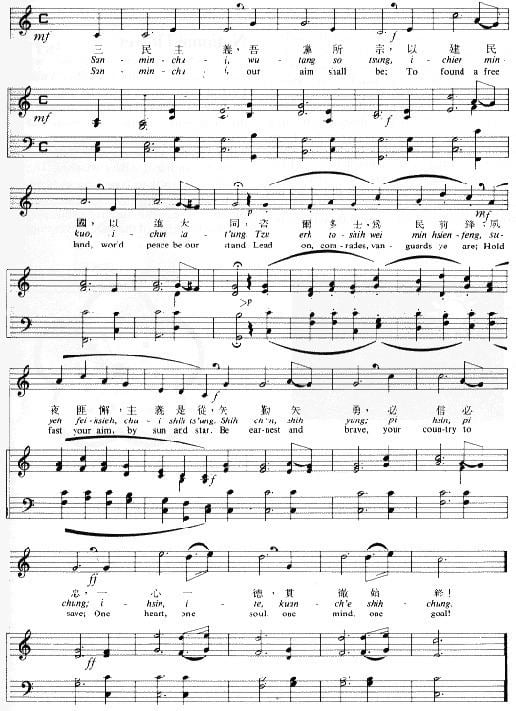 | ||
Adopted 1928 (de facto)1943 (de jure) | ||
The latest National Anthem of the Republic of China was adopted in 1937; previously, Song to the Auspicious Cloud was used as the official anthem of the Republic of China (ROC). it remains the national anthem of the ROC government of Taiwan which remains there; but in mainland China, the anthem serves a historical role. The national anthem of the People's Republic of China is the "March of the Volunteers".
Contents
The anthem's words are adapted from a 1924 speech by Sun Yat-sen, via the anthem of the Chinese Nationalist Party (Kuomintang) in 1937. The lyrics relate to how the vision and hopes of a new nation and its people can be achieved and maintained. Informally, the song is sometimes known as San Min Chu-i from its opening line which references the Three Principles of the People (Sanmin Zhuyi), but this name is never used in formal or official occasions.
History
The text of was the collaboration between several Kuomintang (KMT) party members: Hu Hanmin, Dai Jitao, Liao Zhongkai, and Shao Yuanchong. The text debuted on July 16, 1924, as the opening of a speech by Sun Yat-sen at the opening ceremony of the Whampoa Military Academy. After the success of the Northern Expedition, the Kuomintang party chose the text to be its party anthem and publicly solicited for accompanying music. Cheng Maoyun won in a contest of 139 participants.
On March 24, 1930, numerous Kuomintang party members proposed to use the speech by Sun as the lyrics to the national anthem. The national anthem of the republic was the Song to the Auspicious Cloud. Due to opposition over using a symbol of a political party to represent the entire nation, the National Anthem Editing and Research Committee (國歌編製研究委員會) was set up, which endorsed the KMT party song. On June 3, 1937, the Central Standing Committee (中央常務委員會) approved the proposal, and in 1943, the song officially became the national anthem of the Republic of China.
Lyrics
The lyrics are in classical literary Chinese. For example,
In this respect, the national anthem of the Republic of China stands in contrast to the People's Republic of China's "The March of the Volunteers", which was written a few years later entirely in modern vernacular Chinese.
As well as being written in classical Chinese, the national anthem follows classical poetic conventions. The ancient Fu style follows that of a four-character poem, where the last character of each line rhymes in -ong or -eng, which are equivalent in ancient Chinese.
English translations
The official translation by Du Tingxiu (Theodore B. Tu) appears in English-language guides to the ROC published by the government.
